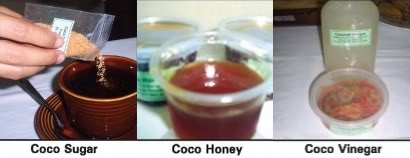The coconut tree as a “tree of life” is characteristically a food supplier as this tree provides fruit throughout the year. The fruit is edible at any stage of maturity. It provides not only solid food but also a large volume of very safe and healthy drinking water.

The fruit of the coconut palm is the is the main source of many food products such as coconut milk/cream, dessicated coconut, coconut chip, coconut water, nata de coco, coconut oil, and copra. Apart from these, the unopened inflorescence can produce coconut sap or toddy which can be processed into high value and nutritious food products.
Coconut sap, the sweet exudate from the tapped unopened spathe or inflorescence of coconut, is a versatile food product because of its many uses. It could be marketed as an alcoholic drink (4-6% alcohol) locally known as “tuba” or coconut wine; as vinegar (under further natural fermentation) or as “lambanog” or distilled wine (24-45% alcohol). The sap can also be processed to sap/juice drink, syrup or honey, crude sugar or granulated brown sugar.
Steps in Processing
Coconut Sap Juice
a) Pasteurize the sap for 10 minutes at 65oC (to prevent natural fermentation).
b) Pour separately in the desired container.
c) Seal tightly and place in the cool section of the refrigerator or freezer if the juice is to be transported to consumers in distant places.
d) If hygienically prepared, the juice can be stored for 3 days.
Coconut Honey or Syrup
a) Boil the sap until it reaches 110o or becomes sticky under moderate to very slow heat.
b) Cool the sticky liquid or coco honey/syrup, then pour into desired container.
c) Store in the refrigerator to prolong shelf life (up to one year without deterioration).
Coconut Sugar
a) Boil coconut sap to evaporate the water under moderate heat with occasional stirring until sap thickens at 115oC.
b) Remove from the flame when it begins to become very sticky.
c) Continue mixing until it becomes granular.
d) Air dry the brown sugar before packing. The pH of coconut sap should be at a level greater than or equal to 6 to ensure successful production of granulated coconut sugar.
One kg of coconut sap sugar can be derived from 2 gallons or 7-8 liters of sweet fresh coconut sap. Coconut sugar is mostly used for cooking desserts and curries and some for raw material of food industries (e.g., confectionery).
Coconut Vinegar
a) Pour harvested sap into a wide and large container. Cover with a clean net to allow aeration and prevent entry of dirt and foreign objects.
b) After the 10 days, harvest the coconut as vinegar.
c) Pasteurize vinegar by heating for 5-10 minutes at 60-65oC to maintain the desired quality (4% acidity) of the vinegar.
d) Allow to cool before placing in very clean bottles. Cover tightly and seal. The coco sap vinegar is a very good ingredient in pickled papaya and as a dip for chicharon and other snack and food preparations.
For more information, please contact:
The Consortium Director
Southern Mindanao Agriculture and Resources Research and Development Consortium (SMARRDEC)
University of Southern Philippines (USeP)
Bo. Obrero, Davao City
Email: [email protected], [email protected]
Website: www.usep.edu.ph/smarrdec
Dr. Patricio S. Faylon
Executive Director
PCARRD, Los Banos, Laguna
Tel. Nos.: (049) 536-0014 to 20; 536-5907
Fax Nos.: (049) 536-0016/ 536-7922
Email: [email protected]
Website: pcarrd.dost.gov.ph


did you export these product?
I need volume of coconut sap vinegar do you supply too
please get in touch with Father Joel Ariza at Chorpus Christi Parish Church here in Iligan City.. we are suki of his coco products and Turmeric Capsules..
I appreciate it very much of the idea in collecting coconut sap. However I think you have to go up every day to cut the portion at the tip of coco flower, so that the sap will continue to flow, until the whole flower will be consume.
I wanted lakbay Aral in places where I cud learn those coco produks. Kindly suggest in what place I may visit tnx.